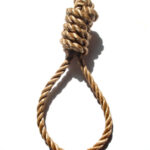Around the turn of the last century, Oklahoma Territory was a sparsely settled land with little in the way of formal law enforcement. Groups like the Dalton Gang and Bill Doolin’s Wild Bunch raided banks, stores and trains in the territory and adjacent states, and for a time they rode with impunity over the plains. Federal marshals were appointed to hunt the outlaws down, and often the desperados would not give up without a fight to the death. When a marshal’s posse returned to the territorial capital of Guthrie, the bodies of outlaws who wouldn’t surrender were buried in Summit View Cemetery. Today, a visit to the cemetery’s Boot Hill section gives a small glimpse into Oklahoma’s Wild West past. Below is a list of the more famous outlaws buried here:
Bert Casey
b. 1881 d. November 8, 1902
Bert Casey, one of the more violent outlaws of Oklahoma Territory, began arousing the attention of lawmen around 1900 with his reputation for stealing horses. In 1901, however, Casey added murder to his list of misdeeds, killing Rufus Choat in March, then Jay Beemblossom August of that year. The murder of Beenblossom was especially heinous; the 11 year old boy was shot when his family did not raise their hands quickly enough during a holdup. These actions made Casey one of the territory’s most wanted men.
Casey hid out at the Hughes Brothers Ranch in Washita County, where he and other outlaws were offered shelter in exchange for performing work around the ranch. Using this ranch as a base of operation, Casey and his gang robbed post offices and stores in the surrounding area throughout 1901 and 1902, meeting anyone who tried to stop them with gunfire. Casey’s quickness to shoot took a toll on law enforcement, with two sheriffs and two deputies from Caddo and Roger Mills counties losing their lives in confrontations with the outlaw in 1902. Several raids on the Hughes Ranch failed to locate Casey, and in the latter half of 1902, public pressure on the Marshal’s office to put an end to the outlaw had grown strong and vocal.
U.S. Marshall Bill Fosset, facing citizen outrage over the failed attempts at capturing Casey, realized that special means would be necessary to bring him to justice. Fosset and Guthrie Territorial Jailer J. L. McCracken conceived a plan to use former members of Casey’s gang to locate the outlaw and bring him in, dead or alive. Fosset and McCracken had two candidates for the job in the Guthrie jail: Fred Hudson, jailed for robbing a post office, and F. M. “Ed” Lockett, a bootlegger. After agreeing to bring Casey in, the two inmates were cleared of the charges holding them, deputized as U. S. Marshalls, armed, and released to hunt the outlaw in late August 1902.
Hudson and Lockett soon found Casey and rejoined him as part of the gang. For a few months, the two undercover marshals rode with Casey, committing small crimes with the gang and waiting for an opportunity to capture their boss. Finally, early in the morning of November 8th 1902, at a camp near Cleo Springs, Hudson and Lockett drew guns on Casey and another gang member, James Sims, and ordered them to surrender. Casey and Sims responded by drawing their pistols, and the marshals fired, killing both Casey and Sims.
Bill Doolin
b. 1858 d. August 24~25, 1896.
William “Wild Bill” Doolin was born in 1858 in Johnson County, Arkansas. A sharecropper’s son, he left his family at age 23 and moved to Oklahoma to work on a ranch as a cowboy. After a few initial run-ins with the law, he joined the infamous Dalton Gang, ran by Bob, Gratt, Emmett, and Bill Dalton. Doolin rode with the Dalton gang over the next few years, robbing trains, depots, and banks. After a botched bank robbery attempt in Coffeyville, Kansas in which almost all of the gang was killed, Doolin formed his own gang known as the “Wild Bunch”. The Wild Bunch was for a time the most powerful outlaw gang in the area, terrorizing southern Kansas and the Oklahoma Territory. Their activities drew the ire of the federal officials in the area, and in 1893 Federal Judge Isaac Parker appointed E. D. Nix as U.S. Marshal for the Oklahoma Territory, with the express purpose of bringing the Wild Bunch to justice.
Nix recruited a force of 100 deputies to hunt down Doolin’s gang and started to work. On September 1st 1893, the gang was tracked to the small territory settlement of Ingalls, where a deputy and a 13-man posse engaged the Wild Bunch in the Battle of Ingalls, what some consider to be the largest shoot-out in Oklahoma Territory history. When the gun smoke cleared, three members of the posse were dead, along with two bystanders. Three members of the gang were wounded, including Doolin, but all but one managed to escape.
Doolin’s gang continued to elude capture until Marshal Bill Tilghman tracked him down and arrested him Eureka Springs, Arkansas on January 15th, 1896. Tilghman brought Doolin back to Guthrie to stand trial, but the night before the trial was to begin, Doolin and several other inmates escaped from the Guthrie jail, fleeing into the darkness. Doolin remained free and on the run until Marshal Heck Thomas learned that he was hiding at his father-in-law’s homestead at Lawson, in present-day Pawnee County, Oklahoma. On August 25th 1896, Thomas and nine deputies surrounded the farm, and confronted Doolin as he was emerging from the barn. Thomas called for Doolin to surrender; in reply Doolin fired a shot at him. The posse returned fire and Doolin was shot and killed. The fatal wound was caused by a round of buckshot, most likely from Thomas himself.
Elmer McCurdy
b. 1880 d. October 8, 1911
Elmer McCurdy was an unusual outlaw; he became more famous in death than he ever did in life. He was born in 1880 to an unwed teenage mother and was raised by his uncle and aunt. After an assortment of odd jobs and a short stint in the army, McCurdy turned toward crime, eventually partnering with Walter Jarrett, a man he met in prison. McCurdy and Jarrett were miserable failures at robbing banks and train safes, often destroying the money inside with the nitroglycerin they used to blast the safes open. After robbing a Kansas train in which the take was only a few dollars, McCurdy got drunk and fell asleep in a barn just south of the Kansas border. He awoke to find that a posse had tracked him down, and he exchanged gunfire with them for over an hour. When the shooting stopped, McCurdy was dead.
McCurdy’s body was taken to a funeral home in Pawhuska where the undertaker embalmed the body with an arsenic-based preservative, a process which mummified the remains. Since no family arrived to take possession of it, the undertaker stood McCurdy’s body up in a corner and charged a nickel for people to come and see the dead outlaw. This went on until 1916, when the body was given to two men claiming to be McCurdy’s relatives, but were actually acquiring his body for a travelling carnival.
For the next sixty years McCurdy’s body travelled the country, being known as “The Mummy Man” or “The Petrified Man”. The body was sold to other carnivals, wax museums, and sideshows and eventually ended up as a prop in the “Laff in the Dark” ride at the Nu-Pike Amusement Park in Long Beach, California, where he remained for more than thirty years. At this point, McCurdy’s body had been painted day-glo yellow, and the park operator assumed it was a mannequin. However, during the filming of an episode of a television show The Six Million Dollar Man, a set worker discovered the true nature of the remains when the mummy’s arm was accidentally broken off. The mummified remains were examined by forensic anthropologists, who linked the remains to McCurdy.
McCurdy’s body was brought back to Oklahoma and buried in the Summit View Cemetery on April 22nd, 1977. On the order of the state medical examiner, two cubic yards of concrete were poured over the casket to make certain Elmer McCurdy did not go wandering again.
Charlie (Charley) Pierce
b. 1866 or 1867 d. May 1, 1895
Charlie Pierce was a member of both the Dalton and Doolin gangs. He was born in the Blue River country of Missouri, was raised in Indiana, and fled to Oklahoma Territory to avoid legal trouble. His father, William Pierce, was an attorney, and he had two brothers. It is known that he spent time in the Fort Smith, Arkansas jail for whiskey peddling. He then joined with the Dalton gang, robbing trains in 1891 and 1892, and was present and wounded at the Battle of Ingalls.
After the 1892 demise of the Dalton gang during a botched bank robbery in Coffeyville, Kansas, Pierce teamed up with Bill Doolin, joining his Wild Bunch gang. After the Wild Bunch disbanded, Pierce, along with George Newcomb, was shot and killed while they slept on May 1, 1895, by the owners of a farm where they was hiding for $5,000 in reward money.
Richard “Little Dick” West
b. 1860 d. 1898
Richard “Little Dick” West was born in Texas around 1860. He met Bill Doolin in 1892 while working on the Halsell Ranch in Oklahoma Territory, and soon joined the Wild Bunch gang. He was wounded during a bank robbery conducted by the gang in Southwest City, Missouri and remained part of the Wild Bunch until Doolin’s death in 1896.
He then helped to form the Jennings Gang, which attempted a number of failed train robberies. In one notable attempt, the gang blew up an entire train car to open a safe, only to find no money in it. Soon after this, the Jennings Gang split apart, and all members were captured and sentenced to jail in 1897 except West. West was tracked by Deputy Marshall Chris Madsen to Guthrie, where West confronted Madsen in a shootout. Madsen gunned down West, putting an end to the last of the last member of the Doolin gang that was on the run.
Sources:
The Logan County Genealogical Society, Summit View Cemetery Rootsweb.
Ken Butler. 1997. Oklahoma Renegades, Their Deeds and Misdeeds Pelican, Gretna, LA.
Oklahoma Historical Society. DOOLIN, WILLIAM M. (1858-1896). Oklahoma Historical Society’s Encyclopedia of Oklahoma History and Culture.
The Logan County Genealogical Society, Elmer McCurdy, Rootsweb.
Charley Pierce. Wikipedia.
Richard West. Wikipedia.



